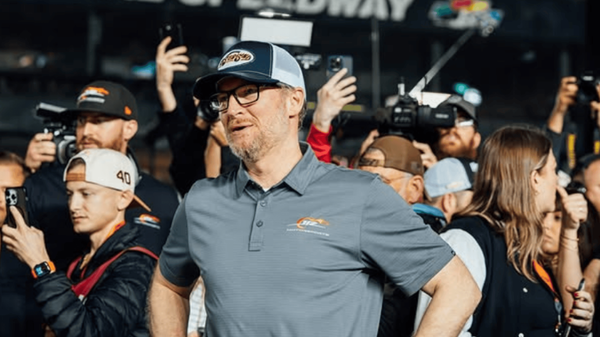
via Imago
source: Imago

via Imago
source: Imago
Connor Zilisch has been turning heads in the NASCAR Xfinity Series this season, racking up eight victories as a 19-year-old rookie for JR Motorsports. His latest triumph came at Portland International Raceway on August 30, 2025, where he started from pole, swept both stages, and led 70 of 78 laps despite late-race chaos. Just two weeks after undergoing collarbone surgery following a victory lane fall at Watkins Glen on August 9, this marked his first full race back, showcasing his resilience on the demanding 1.98-mile road course with its tricky Festival Curves. But the overtime restart in Turn 1 sparked debates about track limits.
Questions arose over NASCAR’s handling of the chicane shortcuts during that frantic finish, with several drivers navigating the penalty area without repercussions. Dale Earnhardt Jr.’s colleague Freddie Kraft, spotter for Bubba Wallace, weighed in on the officiating during a recent podcast episode. “It hurt, but it hurt so good,” Zilisch said post-race about racing through pain, yet the focus shifted to rule enforcement. So what does Freddie Kraft have to say about this incident and the penalty system?
ADVERTISEMENT
Article continues below this ad
Freddie Kraft calls out Connor Zilisch’s Chicane shortcut
In the latest episode of the Door Bumper Clear podcast, Freddie Kraft didn’t hold back on Connor Zilisch’s move during the final restart at Portland, where multiple drivers missed Turn 1 without facing penalties. The incident unfolded on the overtime lap when Zilisch, after contact from William Sawalich earlier, locked up his brakes entering the chicane and opted for the penalty route, a series of A-frame signs meant to slow offenders.
Poll of the day
Poll 1 of 5
AD
This allowed him to emerge ahead amid spinning cars like Sammy Smith and Justin Allgaier, securing the win by 1.572 seconds over Sawalich. Kraft pointed out how Zilisch had practiced the line, noting it provided an advantage since the full chicane includes sharper turns that add time. “Connor took advantage of them. You know, I think what happens here, the restart before this sawalich, comes from 14 rows back and almost wipes everybody out. But he gets into Connor, and when he gets into Connor, it knocks Connor offline, and Connor runs this line through the little Joker deal there,” Kraft explained.
Highlighting how initial contact pushed Zilisch offline but led to a faster path. He emphasized that while Zilisch at least attempted part of the chicane, others like the No. 18 (Riley Herbst), No. 21 (Austin Hill), and No. 16 (AJ Allmendinger) hooked left entirely, avoiding the track surface. This exposed inconsistencies in NASCAR’s self-penalizing system at Portland, where the penalty area, designed with barriers to deter shortcuts, failed to impose real-time losses, as evidenced by no post-race fines or adjustments per the official penalty report.
Kraft argued for stricter enforcement, saying, “I think that Connor should have had to do a stop-and-go. I give him credit for at least admitting that his practice was fast.” He drew parallels to past tracks like the Indianapolis road course, where blowing corners yielded gains, and criticized the removal of grass deterrents at Portland that once prevented such exploits.
The podcast crew, including TJ Majors, agreed this teaches “bad habits,” with Majors adding, “all the cars inside that curb should be stop and go.” This scrutiny underscores broader flaws in NASCAR’s road course rules, where escape roads sometimes reward errors, as seen in Zilisch’s unchallenged lead after the move.
ADVERTISEMENT
Article continues below this ad
The conversation didn’t stop with Kraft’s take, as other drivers also shared their views on the controversial strategy.
What’s your perspective on:
Did Connor Zilisch's shortcut at Portland expose NASCAR's flawed penalty system, or was it smart racing?
Have an interesting take?
Top Stories
Chase Briscoe reacts to Zilisch’s penalty lane gamble
Chase Briscoe, a Cup Series veteran, quickly chimed in on social media about Connor Zilisch’s decision to cut through the Turn 1 penalty area during Portland’s overtime restart. Responding to a replay post, Briscoe highlighted the speed advantage of the shortcut, which allowed Zilisch to weave through A-frames and avoid the wrecking pack behind him. This move, while legal under NASCAR’s rules since no caution was called for the spins in Turns 1 and 2, drew mixed reactions from the garage for potentially undermining fair competition on the road course.
ADVERTISEMENT
Article continues below this ad
“I’d do that every lap if they don’t call it, it’s way faster than he actual corner,” Briscoe posted with a laughing-crying emoji, underscoring how the penalty setup inadvertently benefited those who missed the corner. At Portland, the A-frames are intended to add about two seconds, but Zilisch noted post-race that he had tested it in practice and found it “not really that slow,” committing to it after wheel-hopping on entry. Briscoe’s comment reflects a broader sentiment among drivers that uncalled shortcuts can shift race outcomes, especially in chaotic restarts like this one involving contact from Sawalich and spins by Mayer and Eckes.
While Briscoe’s take adds humor to the debate, it points to the need for NASCAR to revisit track-specific penalties, similar to adjustments at Watkins Glen, where a stop is required in the bus stop escape. Zilisch’s win, his third straight, cements his rookie dominance, but Briscoe’s reaction keeps the focus on whether such maneuvers align with the spirit of racing.
ADVERTISEMENT
ADVERTISEMENT
ADVERTISEMENT
ADVERTISEMENT


Did Connor Zilisch's shortcut at Portland expose NASCAR's flawed penalty system, or was it smart racing?